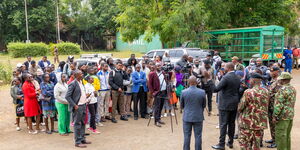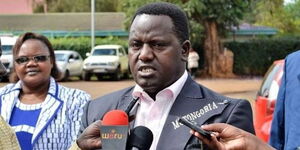As Kenya commits herself to a green future, the role of homegrown innovators in achieving for a more sustainable environment becomes more critical to reducing national net emissions.
The climate innovation startup started by Mike Bwondera, Duncan Kariuki, and one more specializes in designing and constructing a machine that directly captures Carbon dioxide commonly referred to as CO₂ from the air.
The machine directly takes in air blown through it and isolates carbon dioxide through its chemical composition before releasing other unneeded gases and filtering out the concentrated carbon to be stored in alternative solid forms.
The machine uses a filter material that is basic in nature. The atmospheric CO₂ is acidic and that makes for a reaction that forms a salt with saturated CO₂ . Large volumes of air are passed through the machine allowing the other gases to leave while CO₂ reacts to form a salt.
The salt formed after CO₂ reacts with filter material can be turned to stone, stored underground, or recovered for industrial uses.
In Mining, CO₂ is injected into oil fields to help increase oil recovery by reducing the viscosity of the oil and making it easier to pump. Also, Compressed CO₂ can be cooled and pressurized to produce dry ice, which is used for cooling, shipping perishable items, and creating special effects.
Their machine has several advantages over planting trees in the war against carbon. Trees do suck carbon but require a very large space to suck out reliable quantities of carbon. The machine fits in a relatively smaller space while achieving much more results. Trees take at least 5-10 years to mature, the machine works instantly making it more predictable for environmental companies looking to go into carbon markets.
Secondly, though trees are carbon sinks it is hard to specifically quantify exactly how much carbon has been cut out by a tree, One can only estimate based on indicators like transpiration rates.
The machine, however, is scalable and an operator can know down to the unit exactly how much CO₂ has been sucked out in any one session making it easier to claim carbon credit scores without the need to involve many assessors and regulators.
In 2022, as the country was recovering from the pandemic, the trio started their company. The company aims to stay afloat through the sale of its machines and carbon credits. The company is currently innovating on Direct Air Capture machines that can take out up to 10 tons of CO₂ per year which is about what is captured by 1000 trees in a year.
The two founders were students of Engineering at the University of Nairobi when their passion for climate research and innovation led them to pursue a design for a machine that could directly capture from the air. The innovation is poised to enhance Kenya's efforts to become Africa's first carbon-neutral country with Duncan Kariuki advising people to continue planting trees despite the innovation going to market as the country needs all the possible options it can get to reduce atmospheric levels of CO₂ that have serious implications on the nation.
Mike Bwondera, now heading Research and Innovation at the company, reiterated that Kenyan universities have the right talent pool and have already hired 6 engineers straight from campus.
Today, the company employs 6 engineers for its operations. The cost of production in Kenya is much lower compared to the Global North where graduate engineers cost ten times more than in Kenya. Both the supply of renewable energy and talented engineers at a fraction of the cost provides a significant competitive advantage in the company's scaling plan.
Direct air capture technology offers investors the best model to make profits from carbon credits. Today, 1 ton of Carbon removed from the atmosphere is what makes a carbon credit on the carbon markets.












